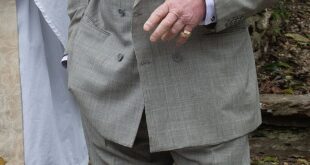One hundred and ten years ago on this date, objects were still bobbing to the surface of the North Atlantic from over two miles below, where the splintered wreck of the Royal Mail Ship Titanic, the most splendid—and since celebrated—ocean liner of its day rested on a gentle slope on the seabed.
There was very little swell when the stern section of the Titanic vanished beneath the calm surface of the ocean at 2:20 a.m. on April 15, 1912, as if she had decided to leave the British registry as peacefully as possible. One survivor said that, for a few minutes, the ship looked like a giant finger pointing up towards the heavens.
Then she was gone and no human eye would see her again for 73 years.
On September 1, 1985, observers in an expedition headed by oceanographer Robert Ballard to locate the remains of two nuclear powered submarines for the U. S. Navy noticed pockmarks on an otherwise smooth ocean floor. Following the trail, they came upon a boiler and, further on, Titanic’s bow section. The initial excitement on the discovery vessel subsided when the magnitude of the tragedy they were gazing upon occurred to the men.
In the days immediately following the disaster, the White Star Line hired the Mackay-Bennett, a ship docked in Halifax, Nova Scotia that was designed for laying underwater cables to recover bodies.
Captain Wilhelm on the liner Bremen had passed through the site of the sinking on April 20. “There were men, women, and children. All had life preservers on. I counted 125, then grew sick of the sight,” he later said. Because of the decidedly negative impact upon the public’s enthusiasm for transatlantic travel, it would be months before other liners ventured into the area.
The Mackay-Bennett arrived at the location, approximately 400 miles off the coast of Newfoundland, on April 21. It encountered the remains of far more victims than it was equipped to retrieve and embalm.
The ship was carrying 190 bodies when it arrived back in Halifax, including that of Charles Cresson Jones. Mr. Jones was returning to Bennington after buying a breed of longhorn sheep in England to improve the stock on Fillmore Farms, where he worked as manager. (He was interred in the Old Bennington Cemetery under a stone that reads, “The Road Leads Home.”)
One hundred and sixteen corpses, assumed to be third class passengers or members of Titanic’s crew, were given nominal religious services on the Mackay-Bennett and their remains were consigned back to the sea. Captain Larnder decided that the settlement of the estates of first class passengers would be expedited if the death was verifiable and gave preferred treatment to bodies that bore the trappings of wealth.
The crew of the Mackay-Bennett could not bring themselves to cast the remains of a small child back into the frigid Atlantic waters, although his clothes indicated he was very likely from third class. The boy was buried in Halifax under a stone that simply read, “Our Babe.” He was finally identified through DNA testing in 2007 as 19-month-old Sidney Leslie Goodwin, whose entire family perished on the Titanic.
In May of 1912, the RMS Oceanic spotted Collapsible A, the last lifeboat to leave the sinking Titanic, adrift 200 miles from the disaster area with the decomposing bodies of three men on board. They would be the last Titanic victims found and were buried at sea.
The basic circumstances of one of the 20th centuries greatest catastrophes hardly bear repeating. Even people with only a slight interest in it know that the Titanic was not carrying enough lifeboats to accommodate the 2,222 passengers and crew on board when she brushed against an iceberg on April 14. Seven hundred and five people survived.
What many people do not know, however, is that before Titanic’s near collision with the liner New York at Southampton and before the fatal iceberg four nights later, there was a fire.
In a recent book, author Senan Molony explored another facet of the Titanic story, one that was only superficially referred to in the American and British inquiries into the disaster and never touched upon in James Cameron’s historically meticulous 1997 film. The book is called “Titanic: Why She Collided, Why She Sank, Why She Should Never Have Sailed.” If the “never have sailed” portion of the title seems a bit overwrought, that doesn’t mean it is not true.
The officers and crew on the brand new White Star ship knew that a coal fire was burning in a three-story tall bunker that abutted a forward bulkhead when it departed the shipping yards at Belfast. It seems likely that harbor officials at Southampton were also aware of the fact. Permission to depart would likely have been denied any other ship, but White Star’s fortunes were dependent on the public’s reliance on their vessels and Titanic was allowed to sail on schedule.
Even under the best of circumstances, coal fires are extremely hard to extinguish. Temperatures can reach as high as 1,800 degrees and proximity to the bulkhead for a prolonged period of time would have substantially weakened the steel. The blaze was finally extinguished a few hours before the encounter with the iceberg by completely emptying the bunker and feeding the coal into boilers and thus increasing the liner’s speed through an area that was known to be dangerous.
Titanic was designed to remain afloat if as many as four of her 16 watertight compartments were breached, but the collision resulted in five being opened to the sea. There was no way the vessel could remain afloat, but Mr. Molony makes a convincing case for the fact that the fire in the huge coal bunker could have resulted in the collapse of the adjoining bulkhead and hastened the liner’s ultimate demise.
Enshrouded in an eternal blackness that would shame the darkest midnight, the lost Titanic is slowly surrendering herself to the elements.
She has, at least, long outlived the fatal iceberg.
Source link


